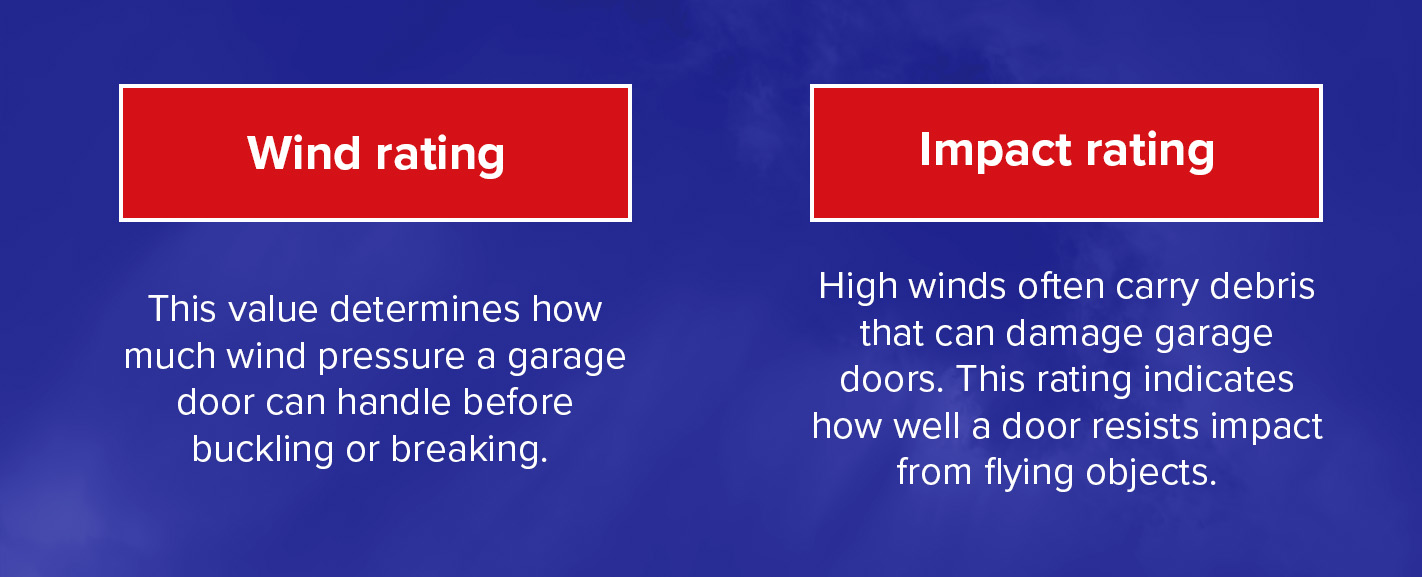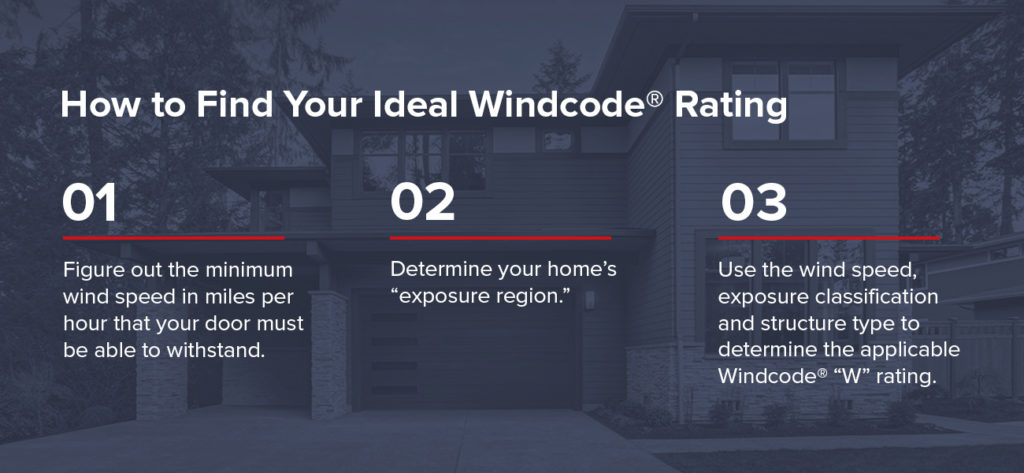Your garage door is the first line of defense against extreme weather events. For South Florida homeowners, a wind-resistant garage door can make all the difference when a hurricane hits. The WindCode rating system indicates the door’s ability to resist specific wind pressures. Understanding your garage door’s wind rating ensures it meets local codes and protects your home from storm damage.
What Is a WindCode Rating?
The Clopay® WindCode rating system determines the strength and durability of a garage door against high winds. It ranks garage doors from W1 to W9 based on wind speed, home exposure and structural type. The higher the “W” value, the stronger the door.
Clopay uses the following to calculate the WindCode rating:
- Location
- Construction materials
- Building dimensions
- Exposure type
- Size of garage door openings
- Local laws and regulations
- Wind speed
- Roof height and angle
Both wind and impact ratings are important for garage doors in storm-prone areas. They differ as follows:
- Wind rating: This value determines how much wind pressure a garage door can handle before buckling or breaking.
- Impact rating: High winds often carry debris that can damage garage doors. This rating indicates how well a door resists impact from flying objects.
The Importance of WindCode Ratings
In hurricane-prone areas like Florida, wind-rated garage doors protect families and homes. Some devastating hurricanes struck the region over the years, including Andrew in 1992, Katrina in 2005 and Irma in 2017. Damage estimates from Hurricane Irma have reached over $300 billion. This persistent threat led to Florida building codes incorporating hurricane-resistant garage door standards.
A compromised garage door allows high winds to enter homes, causing significant damage. Doors with high WindCode ratings can withstand wind pressure from hurricanes or storms. The benefits of these doors include:
- Superior wind resistance
- Protection of structural integrity
- Compliance with local building codes
- Potential insurance discounts
- Savings on costly repairs
View Windcode-Rated Garage Door Styles
Locating Your Garage Door’s Wind Rating
Your existing garage door may already have a WindCode rating. Check the inside of the door for a label with the manufacturer, model and pressure values. The following values indicate the wind rating:
- Design pressure: Your garage door can withstand a certain amount of pressure, measured in pounds per square foot (PSF). It includes both a positive (PSF+) and negative (PSF-) value. PSF+ is the pressure pushing the door inwards, while PSF- is the pressure pulling the door outward.
- Wind speed: The label shows the maximum wind speed that your door can endure in mph.
- “W” rating: Garage doors in South Florida include the wind value rating. Check for a value between W1 and W9 to determine the ability of your door to resist strong winds.
Use this information to check your door’s durability on Florida’s product approval website.
What to Do if Your Door Has No Wind Rating Label
If your door has no wind rating label, check the manufacturer’s manual or search for the model number online. The requirement for wind-rated doors came into effect in 2006. Garage doors manufactured before this time may not meet modern safety standards.
How to Find Your Ideal WindCode Rating
South Florida requires that all garage doors be hurricane-rated. You must know the WindCode rating when investing in a new door to comply with building codes. Follow these steps to find your wind rating.
Step 1: Determine the Minimum Wind Speed
Your garage door must withstand a minimum wind speed in miles per hour based on where you live in South Florida. Visit windspeed.atcouncil.org to find this value. Then, check if your home is in an area prone to wind-borne debris or high-velocity hurricanes:
- Wind-borne debris region: In high-wind areas, flying debris becomes dangerous projectiles during storms. These regions often require impact-resistant building components to protect against debris damage. Properties closer to the shoreline and farther south face a higher risk from wind-borne debris.
- High velocity hurricane zone (HVHZ): Coastal regions like South Florida face the highest risk of extreme winds. These zones have the strictest building codes because structures must withstand the most severe weather conditions.
Step 2: Establish Your Home’s Exposure Region
An exposure region refers to the terrain and structures around a building that affect the wind pressure impact. South Florida contains three exposure region classifications:
- Exposure B: Suburbs, cities and woodlands have many obstructions placed close to one another.
- Exposure C: This category comprises flat terrain and grasslands with various obstructions. Broward and Miami-Dade counties fall under Exposure C unless indicated in Exposure D.
- Exposure D: Buildings within 600 feet of the oceanfront or other large bodies of water more than 5,000 feet across appear in this classification.
Whether your home is one- or two-story can impact your WindCode rating. Taller buildings experience higher wind speed exposure.
Step 3: Select the WindCode Door W Rating
Take the wind speed, exposure and structure type to find the WindCode “W” rating and design pressure. The PSF must be the same as or more than the pressure of the garage door opening. Use the wind load guide chart to locate your door’s appropriate negative and positive PSF.
4. Use the WindCode Calculator
You can also use the Clopay WindCode Calculator to help you determine the ideal WindCode for your home. Input your values into the calculator and click the “Submit To Calculate” button for your results. Please note that the calculator only delivers an approximation. The building code official in your local area has the final say on your garage door’s rating and WindCode compliance.
Request A WindCode-Rated Garage Door Estimate
How to Hurricane-Proof Your Existing Garage Door
If you want to boost the wind resistance of your current garage door, you can follow a few simple tips:
- Know what you need: Check local resources for information about which garage door offers the greatest protection. Your local building code authority is a good place to start. They will likely have the average wind speeds that your garage door should withstand.
- Purchase add-ons: Various products and bracing kits can increase the strength of your garage door. Investing in a durable wind-rated door is easier and more beneficial.
- Use a professional service: Consult with an experienced garage door technician. They can assist in determining the ideal WindCode rating and recommend the right garage door for your needs.
Find the Best Windcode-Rated Garage Doors at The Doorman of Southeast Florida
The Doorman offers a wide variety of high-quality Clopay WindCode-rated garage doors from Clopay. Contact us to learn more about the WindCode rating system or request a free estimate. You can also visit our Boca Raton showroom for a closer look at our product offerings.
Related Posts
Why Is Preventive Maintenance Important for Your Garage Door?
A Guide to Wind-Resistant Garage Doors
Tips for Protecting Your Home Against a Hurricane
How to Protect Yourself From Insurance and Repair Scams After a Hurricane



